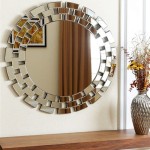Vintage Wood Mirrors: Reflecting History and Style
Vintage wood mirrors offer a unique blend of historical charm and aesthetic appeal, making them sought-after pieces for interior design. More than mere reflective surfaces, they serve as decorative elements that can enhance and elevate a room's ambiance. Their enduring popularity stems from the craftsmanship, materials, and historical context surrounding their creation.
The allure of vintage wood mirrors lies partly in the natural beauty of the wood itself. Different species of wood, each with its unique grain patterns and color variations, contribute to the mirror's character. Commonly used woods include oak, walnut, mahogany, and cherry, often chosen for their durability and aesthetic qualities. The natural aging process further enhances the wood's character, adding depth and patina that cannot be replicated in modern pieces.
Crafting techniques employed in vintage mirror production often involved intricate carvings and embellishments. Skilled artisans meticulously carved designs into the wood frames, showcasing various motifs ranging from floral patterns and geometric shapes to elaborate scenes and figures. These hand-carved details add a layer of artistry and craftsmanship, elevating the mirror from a functional object to a work of art.
The frame's design and construction often reflect the specific historical period in which the mirror was made. Victorian-era mirrors, for example, might feature ornate carvings and gilded accents, while Art Deco mirrors often showcase geometric lines and streamlined forms. Understanding the historical context of a vintage wood mirror adds to its value and provides insights into the design sensibilities of the era.
Beyond aesthetics, the construction methods used in vintage wood mirrors contribute to their durability and longevity. Traditional joinery techniques, such as dovetail joints and mortise and tenon joints, create strong and stable frames that can withstand the test of time. These methods, often requiring significant skill and precision, are a testament to the craftsmanship of the era.
Incorporating vintage wood mirrors into contemporary interiors allows for a fusion of old and new. These mirrors can serve as focal points in various rooms, adding character and a sense of history to the space. They can be hung above fireplaces, in hallways, or in bedrooms, creating an elegant and timeless aesthetic. Their versatility allows them to complement diverse interior design styles, from traditional to eclectic.
Selecting a vintage wood mirror requires careful consideration of several factors. The size and shape of the mirror should be proportionate to the room and the surrounding furniture. The frame's style and finish should complement the overall design aesthetic of the space. Examining the condition of the wood and the mirror itself is crucial, looking for signs of damage or restoration.
Caring for vintage wood mirrors involves maintaining the integrity of both the wood and the mirrored surface. Regular dusting with a soft cloth helps prevent the accumulation of dust and grime. Avoiding exposure to direct sunlight and excessive humidity helps preserve the wood's finish and prevents warping. Cleaning the mirror surface requires gentle techniques to avoid scratching or damaging the reflective backing.
The value of vintage wood mirrors can vary significantly based on several factors. Rarity, condition, age, and the intricacy of the craftsmanship all contribute to the overall value. Mirrors with documented provenance or those attributed to renowned makers often command higher prices. Consulting with antique dealers or appraisers can provide further insights into the value of a specific piece.
The resurgence of interest in vintage and antique items has contributed to the growing popularity of vintage wood mirrors. These mirrors offer a tangible connection to the past, bringing a sense of history and character into modern homes. Their unique aesthetic qualities and durable construction ensure their continued appeal for generations to come.
Identifying authentic vintage wood mirrors involves careful examination and attention to detail. Looking for signs of age, such as natural patina and wear on the wood, can help distinguish genuine vintage pieces from modern reproductions. Examining the construction techniques and the type of wood used can also provide clues about the mirror's age and origin.
The market for vintage wood mirrors offers a wide range of options, from simple and understated designs to elaborate and ornate pieces. Antique shops, flea markets, and online marketplaces provide avenues for discovering these unique treasures. Taking the time to research and carefully evaluate potential purchases can lead to finding the perfect vintage wood mirror to enhance any interior space.
Investing in a vintage wood mirror is not simply acquiring a decorative object; it is acquiring a piece of history. The craftsmanship, materials, and historical context embedded within these mirrors make them valuable additions to any home. Their timeless appeal and enduring quality ensure they will continue to be cherished and admired for years to come.

Vintage Square Wood Mirror

Antique Petite Oval Wood Mirror Vintage Wall Hanging Broe

Rectangular Antique Carved Wood Mirror

Antique Hand Carved Wood Mirror With Classical Details For At 1stdibs Wooden Vintage Mirrors

Antique Tiger Wood Mirror 25h X 18w Dark Framed

Vintage Fluted Gilt Wood Mirror With Faux Patinated Detail Chairish

Antique Oak Wall Mirror Heavy Early Made Carved Details Long Valley Traders

Small Antique Carved Engraved Wood Mirror Circa 1930 For At 1stdibs Wooden

Antique Wall Mirror Wood And Gilded Circa 1950

Vintage French 19th Century Antique Mirror At Revology








